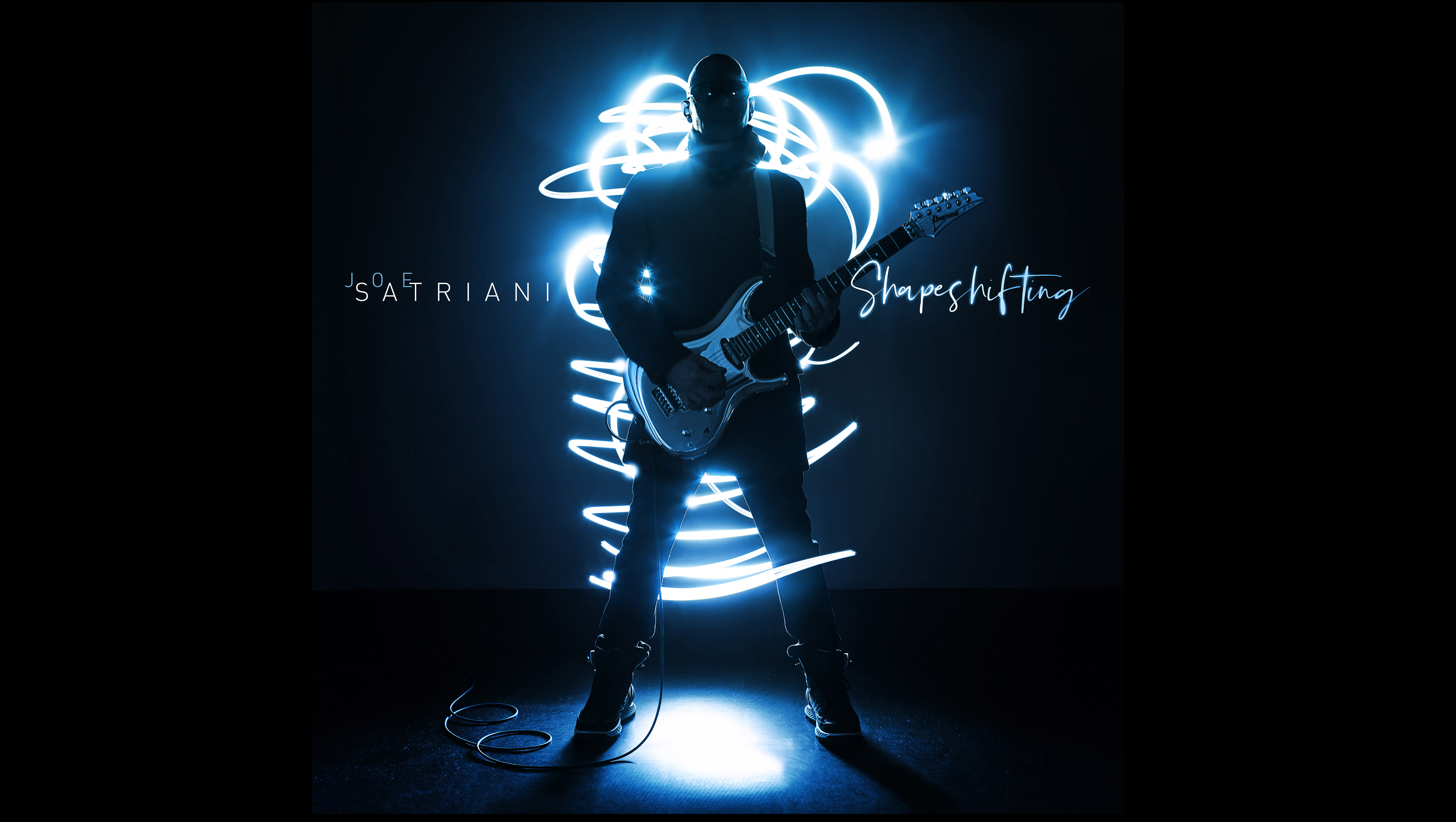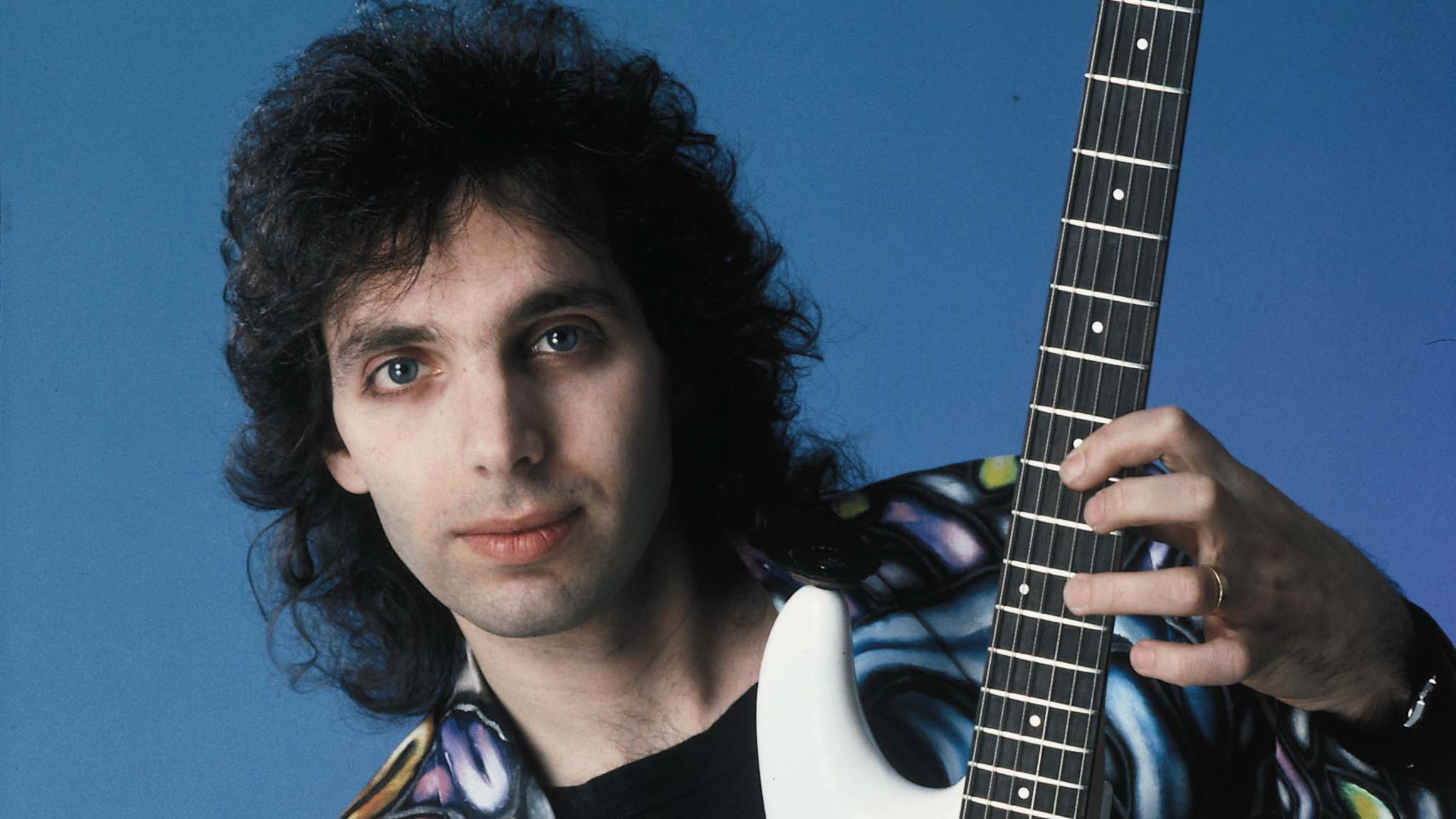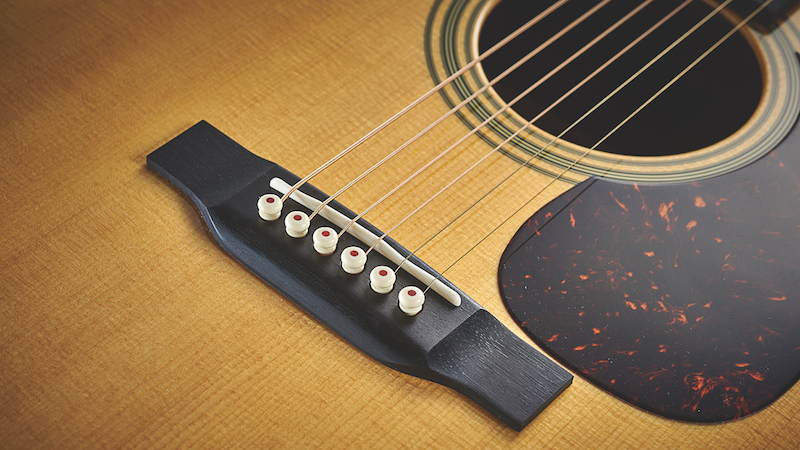Joe Satriani – Shapeshifting: Track-by-track interview
Dreams about aliens, falling stars, Nic Cage being chased through the desert and why collaboration is key to taking his sound forward: this is the ultimate guide to Satch's new album

Joe Satriani gets heaps of props for being an unearthly guitar genius but it’s time we recognised his poetic sensibility, too. He has a gift for naming his tracks and his albums, and telling the story through instrumental composition.
It is a gift that is evident throughout his storied discography, on albums such as 1992’s The Extremist, which was took the electric guitar to the very frontiers of what’s possible with regards technique and composition, and Surfing With The Alien, in which we wrestle with the possibility that, maybe, Satch is the Silver Surfer made flesh, but definitely not of this earth. Then we have Shapeshifting, Satriani’s 17th solo studio album, which continues in this vein.
As Satriani explains as we go track-by-track through the record, Shapeshifting is the theme of the record, of the creative spirit behind it, because there was to be no style off-limits. However the ideas presented themselves, in whatever style, Satriani and his collaborators would find a way to make them work on the record. Joe Satriani would meld himself to the music, not the other way around.
It’s a record that sees Satriani lean heavily on the talents of keyboardist Eric Caudieux, bassist Chris Chaney (who also played rhythm guitar on Falling Stars), Kenny Aronoff on drums, with the likes of Lisa Coleman playing piano on Waiting and Yesterday’s Yesterday and Christopher Guest offering some mandolin parts, too. Everyone who was in attendance seemed to be in on the hand-claps, which, when they come, change the energy of the record and evaporate the notion that Joe Satriani’s solo material is a one-man band.
No, this is a communal thing, everyone contributes. It’s just that, as Satriani explains, it often starts with one his dreams, and they can be kind of crazy…
1. Shapeshifting
Shapeshifting sounds of a piece with your sci-fi concepts but what is the title about?
“I was determined to write in as many different styles as naturally came to me, and
Want all the hottest music and gear news, reviews, deals, features and more, direct to your inbox? Sign up here.

not to worry about making the album a metal album, a blues album, an EDM record, whatever. I wasn’t going to force my compositions into a stylistic tube.
“And that became the theme that lead to me writing Shapeshifting, which was the introduction to the idea that Joe is going to be musically stylistically shapeshifting for every song, so get ready.
"We knew the title track would be first, and Yesterday’s Yesterday would be last, and I just made sure everything had complementary key signatures as the song moved through the sequence.”
2. Big Distortion
“A lot of it was done with the attitude that there was just a bunch of friends hanging out in the clubhouse, looking for the funnest thing to play and hit, so it was really a lot of fun, hard work but a lot of fun.

"When the record comes out and you see all these credits, you’ll see we’ve got my tech and the assistant engineers, everyone is out there hand-clapping and doing whatever they can do. We enlist basically a whole group of people who are hanging around to make the record work.
"Jim Scott [co-producer, plus whistling, percussion and hand-claps] would be really great at managing the scene inside the room, the emotions, the different musicians and their temperaments, and he was really great at knowing when was a good take and when was not a good take.”
3. All For Love
“This is a crazy long story about this song. I started writing that and made my first recording of it in the late ‘90s, and it was exclusively recorded on a Kurzweil K2000 DAW keyboard, and it was in my mind simply going to be an introductory orchestral piece. It just stayed on that keyboard. Around 2001 I made a CD of it and gave it to John Paul Jones because we had talked about doing an orchestra project together, and it never happened.

“Anyways, fast-forward to last year and I am going through material, I hear it again and think I really love this song but it is not a guitar song. I came up with a rhythm part, with the odd envelope filter on it, and then I thought, ‘Okay, what if I tried to play that melody on the guitar?’ Then I discovered how hard it was to play that melody in that register, so high in the neck, and keep it in tune and keep all the noises you get on guitar when you are bending and pushing with a lot of gain on your amp, it was just such a difficult task.
“I did 10 takes of the song and the first take, I played just the live part, and I was really discouraged just because I sounded horrible. It was just so noisy, and it was so hard to keep the intonation properly in check for the feeling of the song. We wound up using 99 per cent of Take 10, and the only melody solo bit that was from my home demo was that sort of neoclassical sounding solo, right before it goes back to the melody.”
4. Ali Farka, Dick Dale, An Alien And Me
“Part of the passion behind putting those two guys in the song, paying proper homage to their legacy and their musical contribution. I was in my studio one day, and I was going over music cues that I had written and recorded for a sci-fi animated show that has not yet been made and I was listening to this one synthesizer improv that I did on a program called Massive, and I thought, ‘Oh, this is so cool. It kind of reminds me of a North African thing.’
“And then I thought I’ll pick up a guitar, and I just happened to have a Telecaster in the studio, and I started playing like Ali Farka. I recorded ambiently what was happening in the room with my phone and then I went out last year on the Hendrix tour, and I was listening to this thing every day, thinking I had to write this tribute song to Farka. Then, unfortunately, we lose Dick Dale, and as I was reading up on his life and history I thought to myself, ‘I need to include him in this song.’

Classic guest lesson: Joe Satriani shows you two exotic scale practice licks
“I needed a device in order for me to imagine how the two people could be in one song together, and I had this daydream about being at a party, late at night, maybe out in an oasis in North Africa or whatever, and it’s Ali Farka and it’s Dick Dale, and it’s me, and there’s this sort of alien synthesizer thing! And I know it sounds ridiculous but I just thought, ‘What if that really happened? What would we play together? How would we play together?’ I tell you what, my right arm and my elbow were just hurting after doing those Dick Dale parts.”
5. Teardrops
“Kenny loved all the demos where the drums were very minimal. He wanted to play with that [space], and the drum kit is an amazing instrument if you allow it to breathe. It really is beautiful sounding when you hear it back because you can hear so much tone from the drums when there is space for that tone to lay itself out in front of you, but you are are constantly hitting it with 64th notes there is not much you are going to hear.
“And then Jim Scott? I can’t say enough about how wonderfully he mixed the record, and how he even took it further than I thought we could, but everytime he would push one thing way on the side and let it be very dynamic and use only two out of the four guitars that were doing something. He created that space because his ear is really amazing. He knows how to make a track sound great, and when you take it out and play it in your car or on your phone it just sounds great.”
6. Perfect Dust
“That was something putting that together. That was a demo that was a challenge for everyone. Part of it, again, was me telling my story about it. I told them that it was inspired by this poem Mexico City Blues, by Jack Kerouac, and there is a section where he is talking about being dead and buried and turning into dust, and he uses the phrase ‘perfect dust.’ I was just thinking – again, a visualisation – of being in a cemetery and below ground the dead have no worries and maybe they are having a party down there, and then above ground, people are bereaved and they are sad because they have lost their loved ones. I thought I was going to write a song for those two parts.
“That was a funny one to describe to everyone but it kind of helped them go the distance with their parts. It was so much fun putting that together. We used a lot of different guitars and amps on that one.
"That was the one where the melody, that half-time melody that comes in, I played that for hours. I mean when it comes to a beautiful melody you can play it so many different ways, and I drive so many people crazy by just playing one of the notes in 25 different ways and making them sit through all of it while I figure out what’s the best version of every single note. In the end, you want to feel that it is compelling and that it reaches right into your heart.”
7. Nineteen Eighty
“Last year we worked on a labour of love to get the Squares anthology out, our one and only album, our one and only best-of. After 39 years we scored a record deal. We were very pleased and shocked that we got a record deal and that it got released, but when it was all over I had this feeling like there was one thing left that needed to be done.
“I needed to somehow express in a song the enthusiasm I had at the beginning of the Squares period, which really was the end of ’79, the beginning of 1980, and it was still a more swing-y, happy guitar moment, and not so shreddy like 1985 or ’88. It hadn’t gotten all dark and over the top. It was still Eddie Van Halen and Mark Knopfler. It was still Brian May and AC/DC and it was fun.
“When I started working on that I said, ‘Well I am just going to write a song that is like what I wanted to do and maybe didn’t do it because we were trying to be more new wave or something.’ I was the rocker in the band so the other guys tried to get me to unrock myself a bit! [Laughs]

I was literally in my home studio and there on the floor was an Eddie Van Halen MXR Phase 90, with the special Eddie paint job on it, and I said, ‘I have to use this!’
“I can’t tell you how happy I was that Eddie came on the scene and just lifted up guitar playing again, and he had what you just said, he had that Friday night tone, that Friday night attitude. It was devastatingly perfect; his timing was just so perfect, and he wrote such good songs.”
8. All My Friends Are Here
“That is a thing that I brought in that I was hoping everyone on the team would respond to. You never really know when people come in and they have their own ideas what might make your demos really work as real tracks.
"The first comment I got was from Eric Caudieux, who got my demo first, and he said, ‘Do I have permission to replace some of your keyboard parts with things that are more transparent?’ And I said, ‘Absolutely! That’s why I invited you to the project, to replace my crummy little home keyboard parts!’ [Laughs] He has an enormous amount of really good musical taste.”
9. Spirits, Ghosts and Outlaws
“Spirits… was the rush of a cinematic moment in the middle of the night, out in the desert, and I couldn’t quite tell if it was riding horses fast or a motorcycle on fire! [Laughs] Nicolas Cage being chased by spirits and outlaws! I remember thinking, ‘Keep it raw and just keep the movement going.’ The song has got to feel like it is always moving forward really fast into some unknown territory, but there is some sort of spiritual feeling about it that is good, and that is a hard thing to do.
“When we are about to do a song, I’ll sit everybody down and say what I was thinking. Everybody loved the image of Nicolas Cage being pursued by spirits, ghosts and outlaws. Jim kept that in mind to keep that vibe going and not to put too many instruments on it, to really make it sound like a dangerous rock band out in the desert – along with Nicolas! [Laughs].”
10. Falling Stars
“I didn’t write it at night but it is based on a crazy set of dreams where there was no rhyme or reason or explanation of the non-reality aspect of the dream.

"Things in the dream didn’t go together and I kept hearing in my mind this major chord and this minor chord, two separate things, and then I was feeling like it is a song that isn’t quite sure if it is night or day, if it’s light or dark, and represented by the two chord changes.
"The song really is trying to put music, to create a soundtrack to this dream that was very difficult to understand. I still don’t know what the dream is about but the song is a representation of that.”
11. Waiting
Lisa Coleman’s piano on this really makes it feel like a two-hander…
“It is important for me to let people know that this album, like all my albums, they are a group effort and I credit everybody for everything that they did. I really can’t make these records without the talent and support that I bring in.”
12. Here The Blue River
Where did the Trojan Records / Al Anderson vibe come from?
“I am not sure. I didn’t set out to make a reggae song at all. I was just being inspired by someone else’s poetry, and then I just started to work on the track, and I just didn’t think… It was all part of the process of making this album, not to discriminate against any style that came into my head.
"That was a poem that inspired me. One day I was reading a poem by Ralph Waldo Emerson called The River, and it is a beautiful, beautiful poem. So I am reading this and it is making me think of my childhood, places in nature, visiting them with my parents.”
13. Yesterday’s Yesterday
“When we were working on it it would just lift everybody’s spirits, and then somewhere down the line we all started whistling along with it, and we all looked at each other like, ‘Hey, maybe we should whistle on this song.’ Then we were thinking, ‘How many songs have there been with whistles on? What was the last hit song with a whistle on it? What is the most-popular song whistling song! [Laughs]’

Best acoustic guitars: top acoustic guitars for beginners and pros
“Jim, Eric and myself went out and we stood over the drum mics and as it turned out, thankfully, Jim and Eric are world-class whistlers, and I was the weak link in the chain. I was using a bunch of acoustic guitars.
"I picked a fairly new Martin D-28, very nice sounding, action set pretty low, and I think Jim close-mic’d it. He also took a feed off the pickup. And then Lisa came in and she added a beautiful piano piece and my friend Christopher Guest gave us really nice mandolin recordings. I am so happy it ended up on the album. I really do love that track.”
Shapeshifting is out now on Sony Music/Legacy Recordings.
Joe has rescheduled his Shapeshifting UK tour to now begin on 29 April, 2021. Tickets for his May 2020 UK tour remain valid for the rescheduled 2021 dates. Visit satriani.com for more info.
Jonathan Horsley has been writing about guitars and guitar culture since 2005, playing them since 1990, and regularly contributes to MusicRadar, Total Guitar and Guitar World. He uses Jazz III nylon picks, 10s during the week, 9s at the weekend, and shamefully still struggles with rhythm figure one of Van Halen’s Panama.
